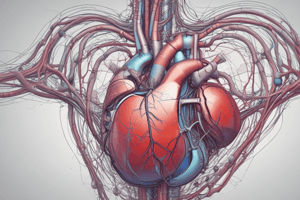Podcast
Questions and Answers
What is the function of the SA node in the heart?
What is the function of the SA node in the heart?
The SA node functions as the cardiac pacemaker, generating electrical impulses that initiate heartbeats.
Explain the process of self-excitation in SA node cells.
Explain the process of self-excitation in SA node cells.
Self-excitation occurs when SA node cells generate an electrical current due to the movement of ions across their membranes.
Why are the internodal pathways important in the electrical conduction of the heart?
Why are the internodal pathways important in the electrical conduction of the heart?
Internodal pathways transmit electrical signals quickly throughout the right and left atria, facilitating coordinated atrial contractions.
What role does the AV node play in the cardiac cycle?
What role does the AV node play in the cardiac cycle?
Describe the path of electrical impulses after they leave the AV node.
Describe the path of electrical impulses after they leave the AV node.
What is the significance of the contraction direction in the ventricles?
What is the significance of the contraction direction in the ventricles?
How do the conduction fibers enhance heart function?
How do the conduction fibers enhance heart function?
What is polarization in the context of SA node activity?
What is polarization in the context of SA node activity?
What is the primary function of the Purkinje fibers in the cardiac conduction system?
What is the primary function of the Purkinje fibers in the cardiac conduction system?
Where is the sinoatrial (SA) node located, and what role does it play in heart activity?
Where is the sinoatrial (SA) node located, and what role does it play in heart activity?
Describe the relationship between the SA node and the AV node in terms of electrical conduction.
Describe the relationship between the SA node and the AV node in terms of electrical conduction.
What is the significance of the AV node in the cardiac conduction system?
What is the significance of the AV node in the cardiac conduction system?
How does the structure of the cardiac conduction system contribute to its function?
How does the structure of the cardiac conduction system contribute to its function?
Flashcards are hidden until you start studying
Study Notes
Cardiac Pacemaker and Electrical Signal Transmission
- The sinoatrial (SA) node, located in the right atrium, acts as the heart's natural pacemaker.
- SA node cells possess the ability to generate electrical currents through a process called self-excitation.
- Sodium, calcium, and potassium ions move in and out of SA node cells via different membrane channels, altering the electrical charge across the cell membrane.
- These charge changes, known as polarization, create an electrical current that travels through atrial muscle fibers.
- The electrical signal travels more rapidly through specialized fibers within the atrial wall, called internodal pathways, ensuring efficient transmission to both atria.
- Atrial muscle fibers contract as the electrical impulse reaches them.
- The signal passes from the internodal pathways to the atrioventricular (AV) node, where it slows down, allowing time for the atria to fully empty before ventricular contraction.
- The AV bundle, located just below the AV node, conducts the signal into the ventricles.
- Within the ventricles, the AV bundle branches into right and left bundles, which comprise Purkinje fibers and distribute the signal throughout the ventricular walls.
- The impulse reaches the apex of the heart first, initiating ventricular contraction from the bottom up, pushing blood towards the base and out into the appropriate arteries.
- Conduction fibers facilitate rapid transmission of the electrical impulse throughout the heart, ensuring coordinated contractions for efficient blood pumping.
Cardiac Conduction System
- The cardiac conduction system is a network of modified cardiac muscle cells within the heart.
- The Purkinje fibers are specialized cells within the cardiac conduction system that conduct electrical impulses through the heart muscle.
- The sinoatrial (SA) node is a cluster of cells in the right atrium that is responsible for generating the normal electrical impulses that initiate the heartbeat.
- The atrioventricular (AV) node is located at the junction of the atria and ventricles, acting as a gate that allows electrical impulses to pass from the atria to the ventricles.
Studying That Suits You
Use AI to generate personalized quizzes and flashcards to suit your learning preferences.




